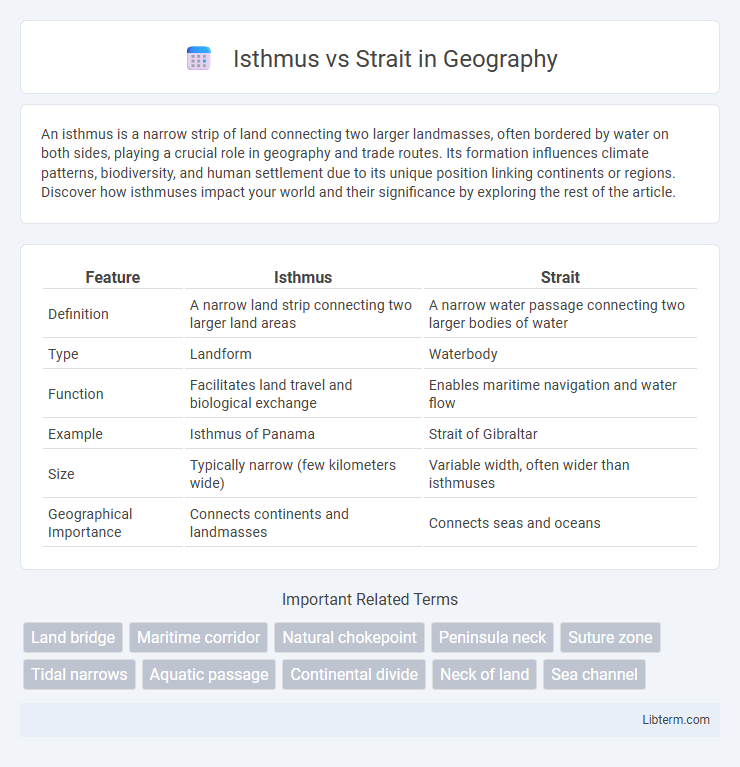An isthmus is a narrow strip of land connecting two larger landmasses, often bordered by water on both sides, playing a crucial role in geography and trade routes. Its formation influences climate patterns, biodiversity, and human settlement due to its unique position linking continents or regions. Discover how isthmuses impact your world and their significance by exploring the rest of the article.
Table of Comparison
| Feature | Isthmus | Strait |
|---|---|---|
| Definition | A narrow land strip connecting two larger land areas | A narrow water passage connecting two larger bodies of water |
| Type | Landform | Waterbody |
| Function | Facilitates land travel and biological exchange | Enables maritime navigation and water flow |
| Example | Isthmus of Panama | Strait of Gibraltar |
| Size | Typically narrow (few kilometers wide) | Variable width, often wider than isthmuses |
| Geographical Importance | Connects continents and landmasses | Connects seas and oceans |
Definition of Isthmus
An isthmus is a narrow strip of land connecting two larger landmasses, crucial for land transportation and often influencing geological and ecological connectivity. In contrast, a strait is a narrow waterway connecting two larger bodies of water, impacting maritime routes and aquatic ecosystems. Understanding the definition of an isthmus highlights its role in terrestrial geography and its distinction from maritime passages like straits.
Definition of Strait
A strait is a narrow body of water connecting two larger bodies of water, facilitating maritime navigation and often serving as strategic maritime chokepoints. Unlike an isthmus, which is a narrow strip of land connecting two larger landmasses, a strait is defined by its water geography and is significant for its ecological, economic, and geopolitical roles. Notable examples of straits include the Strait of Gibraltar and the Strait of Hormuz, each critical for international shipping routes.
Key Differences between Isthmus and Strait
An isthmus is a narrow land strip connecting two larger land areas, while a strait is a narrow water passage linking two larger bodies of water. Isthmuses serve as crucial land bridges facilitating terrestrial movement and often host significant transportation routes, whereas straits are vital maritime channels impacting navigation, ocean currents, and geopolitical boundaries. The primary distinction lies in their physical composition--land for isthmuses and water for straits--and their functional roles in geography and human activity.
Geographical Significance of Isthmuses
Isthmuses serve as narrow land bridges connecting two larger landmasses, playing a crucial role in the migration of species and the movement of human populations throughout history. Unlike straits, which are narrow waterways connecting two larger bodies of water, isthmuses facilitate land transportation routes and can influence geopolitical and economic dynamics by providing essential overland passageways between continents or regions. Notable examples include the Isthmus of Panama, vital for the Panama Canal, and the Isthmus of Suez, critical for connecting Africa and Asia.
Geographical Importance of Straits
Straits are narrow waterways that connect two larger bodies of water, serving as critical channels for maritime navigation and international trade. Their geographical importance lies in facilitating global shipping routes and strategic military passage, often controlling access between seas and oceans. Key examples include the Strait of Hormuz and the Strait of Malacca, which are vital chokepoints influencing global energy supplies and commerce.
Famous Examples of Isthmuses
The Isthmus of Panama is one of the most famous isthmuses, connecting North and South America while separating the Atlantic and Pacific Oceans. Another notable example is the Isthmus of Suez, linking Africa and Asia and hosting the crucial Suez Canal, a key maritime shortcut. The Isthmus of Corinth connects the Peloponnese peninsula to mainland Greece, serving as a strategic land bridge in the region.
Notable Examples of Straits
Straits such as the Strait of Gibraltar, linking the Atlantic Ocean and the Mediterranean Sea, and the Bering Strait, separating Asia and North America, serve as crucial maritime passages connecting two larger bodies of water. Unlike isthmuses, which are narrow land bridges connecting two landmasses, straits are natural water channels facilitating significant international shipping and strategic naval routes. The Malacca Strait and the Bosporus Strait also stand out as vital global chokepoints influencing trade and geopolitical dynamics.
Roles in Human History and Trade
Isthmuses like the Isthmus of Panama have played critical roles in human history by enabling land-based trade routes and facilitating the construction of canals, such as the Panama Canal, which dramatically shortened maritime pathways. Straits such as the Strait of Hormuz and the Strait of Malacca serve as vital chokepoints for global maritime trade, controlling key shipping lanes that connect major oceans and enable the transport of vast quantities of oil, goods, and resources. Both land bridges and narrow sea passages have shaped economic, military, and cultural exchanges by influencing trade networks and strategic geopolitical control throughout history.
Environmental Impact of Isthmuses and Straits
Isthmuses, as narrow land bridges, often disrupt natural water flow and marine ecosystems when altered by human activities such as construction or land reclamation. Straits, being natural water passages, support rich biodiversity but face environmental challenges from pollution, shipping traffic, and habitat fragmentation. Both landforms influence local climate and sediment transport, with interventions potentially causing erosion, loss of habitats, and changes in water salinity and temperature that affect marine life.
Summary: Choosing Between Isthmus and Strait
An isthmus is a narrow strip of land connecting two larger landmasses, while a strait is a narrow waterway connecting two larger bodies of water. Choosing between an isthmus and a strait depends on whether the focus is on land-based connections or water navigation routes. Understanding their geographic functions optimizes decision-making in fields like transportation, ecology, and geopolitics.
Isthmus Infographic

 libterm.com
libterm.com